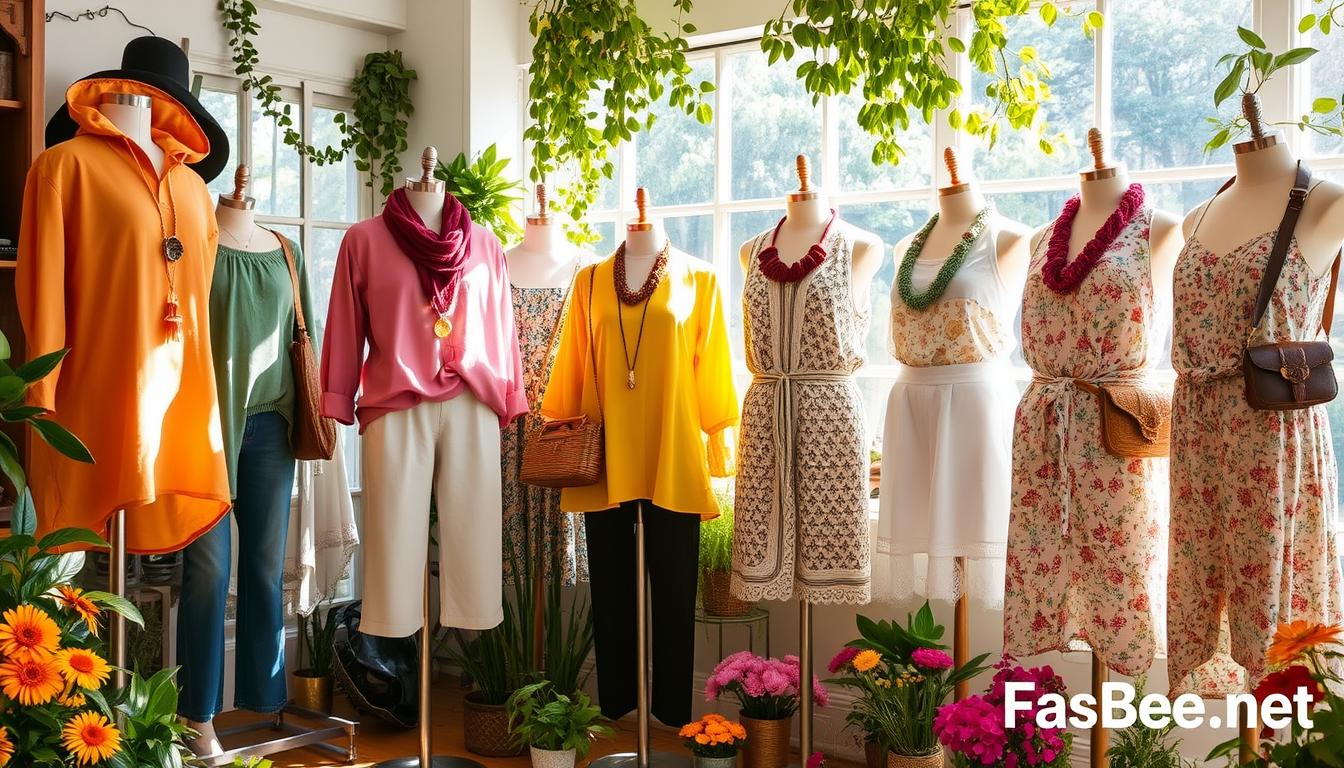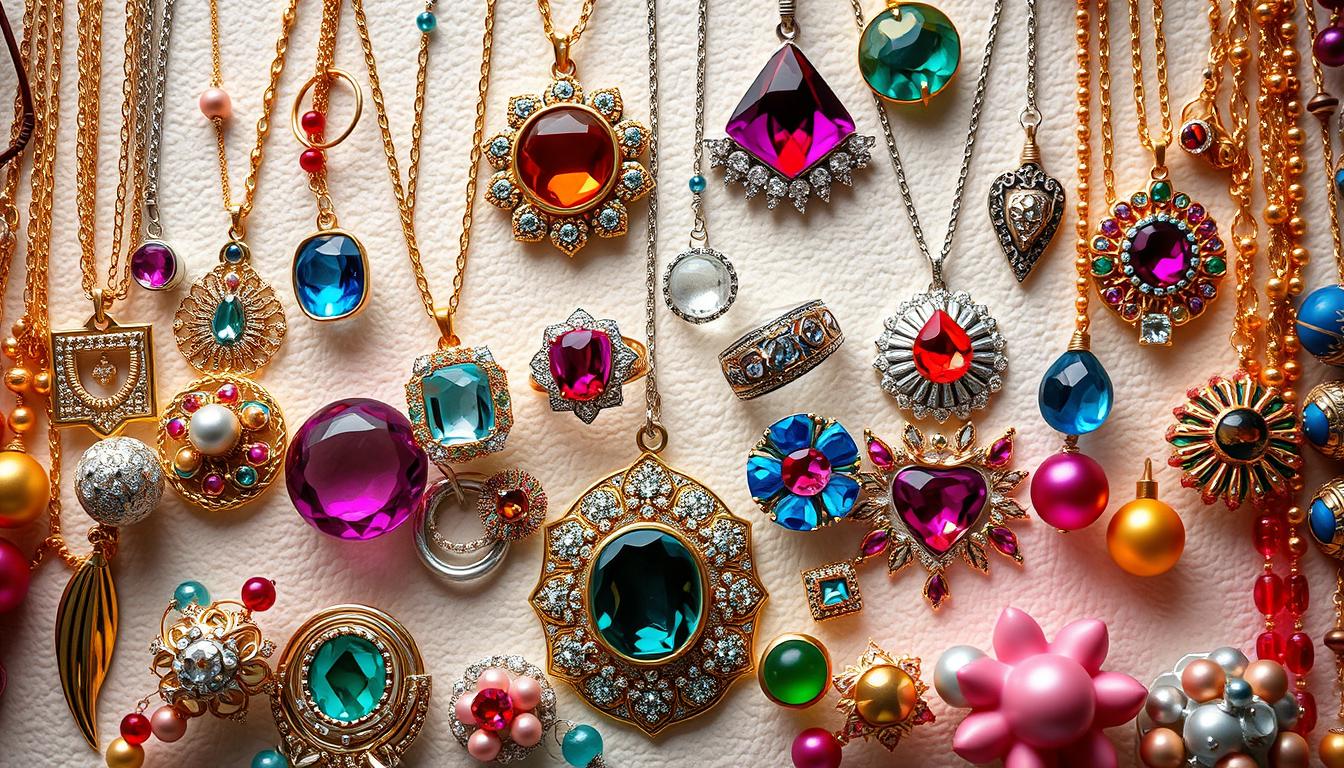Earth Day reminds us to shop greener. Building an ethical wardrobe might seem hard, but it’s worth it. Every step towards being a more conscious consumer is good.
The fashion world is huge, causing 10% of global greenhouse gas emissions. It harms the environment, including forests, water, and toxic waste. Workers often face bad conditions and low pay. Today, clothes are worn just seven times before they’re thrown away.
Starting a sustainable fashion journey can feel big, but it’s empowering. By choosing wisely and caring for our clothes, we can help the planet and support fair fashion.
Key Takeaways
- The fashion industry contributes 10% of annual global greenhouse gas emissions, with significant environmental and social impacts.
- Sustainable fashion focuses on eco-friendly materials, ethical manufacturing, and mindful consumption.
- Choosing well-made, trans-seasonal clothing and adopting a capsule wardrobe can reduce waste and support sustainable practices.
- Exploring secondhand and vintage options, as well as supporting local artisans and ethical brands, can help build a sustainable wardrobe.
- Proper care and maintenance of clothing, such as repairing and upcycling, can extend the life of garments and minimize waste.
Understanding Sustainable Fashion
The slow fashion movement is growing as more people want clothes that are good for the planet. Sustainable fashion aims to lessen the harm caused by making, selling, and wearing clothes. It involves using organic materials, fair labor, and encouraging clothes to be made over and over again.
What is Sustainable Fashion?
Sustainable fashion means making clothes in a way that’s kind to the environment and people. It uses materials like organic cotton and recycled polyester. It also means treating workers fairly and paying them a living wage.
Why is it Important?
The fashion world is a big polluter and uses up a lot of resources. Sustainable fashion tries to fix these problems. It helps the planet, supports local communities, and makes sure workers are treated right.
Key Principles of Sustainability
- Circularity: Designing products for longevity, repurposing, and recycling to minimize waste.
- Ethical production: Ensuring fair wages, safe working conditions, and transparency in supply chains.
- Renewable and recycled materials: Prioritizing the use of organic, sustainable, and recycled fabrics.
- Responsible consumption: Encouraging mindful purchasing, extended product use, and responsible disposal.
- Collaboration and innovation: Fostering industry-wide cooperation and technological advancements to drive sustainable change.
By following these principles, the fashion world can become more sustainable. This will help the planet, people, and the industry itself.
The Impact of Fast Fashion
The fashion world has faced criticism for its unsustainable ways. Fast fashion has made things worse, harming the environment and people. This quick production and use of clothes have big effects, going beyond just money.
Environmental Costs
Fast fashion’s damage to the environment is huge. It’s behind about 10% of global carbon emissions, more than flights and ships together. Also, 85% of all clothes end up in landfills, adding to waste and pollution.
Dyeing and finishing clothes pollute a lot, making up 36% of the industry’s pollution. Yarn and fiber production add another 43%. By 2030, emissions from making clothes could rise by 60%, making things even worse.
Social Implications
The fashion world uses cheap labor in poor countries, leading to bad working conditions and low pay. Young women often work long hours for little money. This exploitation hurts many people and makes the fashion world unfair.
Economic Factors
The fast fashion model focuses on cheap, trendy clothes, changing how we see clothes. Now, we see them as disposable, not lasting items. This has made clothes less valuable, making it hard for eco-friendly brands to succeed.
The slow fashion movement fights against fast fashion’s harm. It pushes for better ways to make clothes and changes how we shop. Brands like ThredUp Inc., Poshmark, Rent the Runway, and Mud Jeans offer secondhand and rental options, showing there are better ways.
To fix the fashion industry’s problems, we need more ethical manufacturing and sustainable practices. By choosing better, we can make the industry better for everyone and the planet.
Essential Sustainable Fabrics
The fashion world is facing big environmental challenges. But, eco-friendly materials are bringing hope. Fabrics like organic cotton and recycled polyester are changing how we make and wear clothes.
Organic Cotton
Organic cotton is a top choice for its eco-friendly and fair production. It’s grown without harmful chemicals, using rain and groundwater. But, a New York Times report shows we need more honesty in organic cotton.
Tencel and Lyocell
TENCEL Lyocell is a standout fabric. It’s 50% more absorbent than cotton and uses less water and energy. Its production also cuts down waste and uses recycled cotton, helping the fashion circle.
Recycled Materials
Recycled fabrics like ECONYL and CIRCULOSE are becoming key in green fashion. ECONYL is made from plastic waste and old fabrics, using less water and waste. CIRCULOSE turns old clothes and waste into new fibers.
Hemp and Bamboo Options
- Hemp: Hemp fabric breaks down quickly, making it very sustainable.
- Bamboo: Bamboo breaks down fast if not treated, needing little resources. It’s a green choice for clothes.
These green materials are leading the fashion world towards sustainability. They cut down on clothes’ environmental harm. By choosing eco-friendly materials, we’re moving towards a greener future.
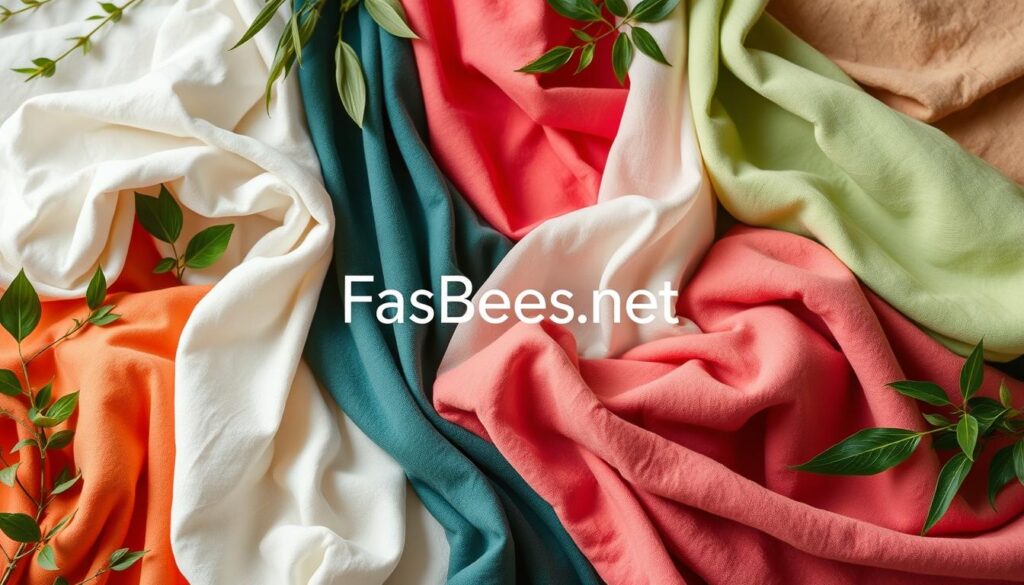
“Sustainable fashion is not just a trend – it’s a necessary shift towards a more responsible and environmentally-conscious industry.”
Ethical Brands to Support
Looking for sustainable fashion? There are many ethical brands to choose from. These brands focus on the environment, fair labor, and being open about how they make things. You can find everything from big names to local artists and fair trade groups.
Leading Sustainable Fashion Brands
Patagonia is a leader in sustainable fashion. They make clothes from recycled materials and fix them for free. Everlane, Veja, Reformation, and Eileen Fisher also lead the way. They all share details about where their clothes come from and how they’re made.
Local Artisans and Fair Trade
Supporting local artisans and fair trade groups is powerful. They use old ways and natural stuff, making clothes that are good for the planet and people. Their clothes are stylish and eco-friendly.
Brands with Transparency Practices
Brands that are open about their ways are key to sustainable fashion. Patagonia, Everlane, and Reformation are known for this. They share info on their supply chains and how they affect the environment. Look for brands rated “Good” or “Great” by Good on You.
“The top sustainable fashion brands are not only committed to reducing their environmental footprint but also prioritizing fair labor practices and supply chain transparency.”
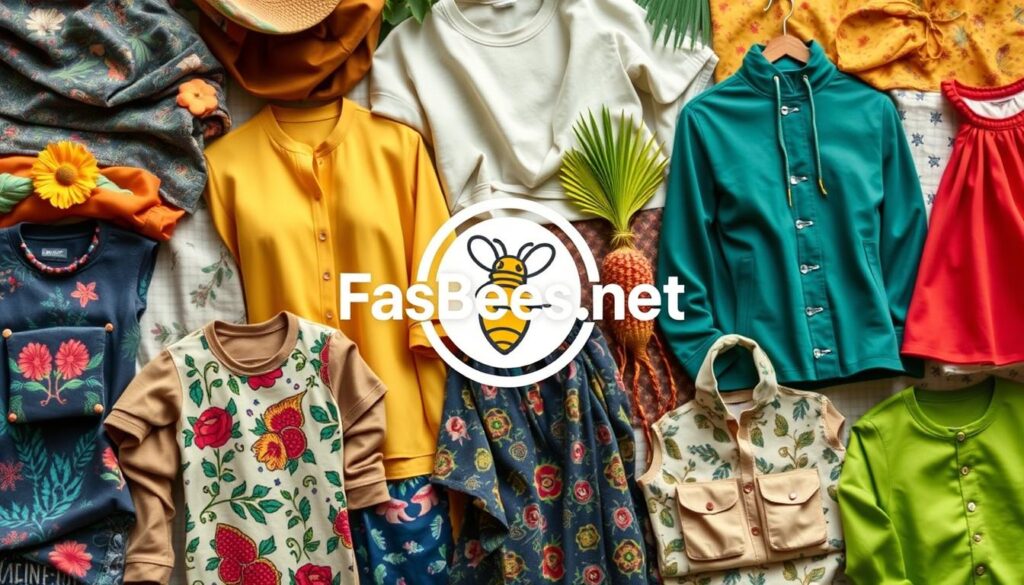
Tips for Building a Sustainable Wardrobe
The slow fashion movement is growing, making sustainable wardrobes key. By choosing wisely, you can lessen your environmental impact and support fair fashion. Here are some tips to build a wardrobe that’s good for the planet:
Evaluate Your Existing Closet
Look closely at what’s in your closet. Check the quality, condition, and how often you wear each item. This helps you decide what to keep, donate, or replace with better choices.
Adopt a Capsule Wardrobe
Try a capsule wardrobe with a few, versatile, high-quality pieces. This way, you invest in fewer, but better, items. It cuts down on waste and helps you shop smarter.
Focus on Quality over Quantity
When buying new, choose quality over quantity. Go for durable, eco-friendly clothes that last, not cheap, fast fashion. This approach makes your wardrobe both green and lasting.
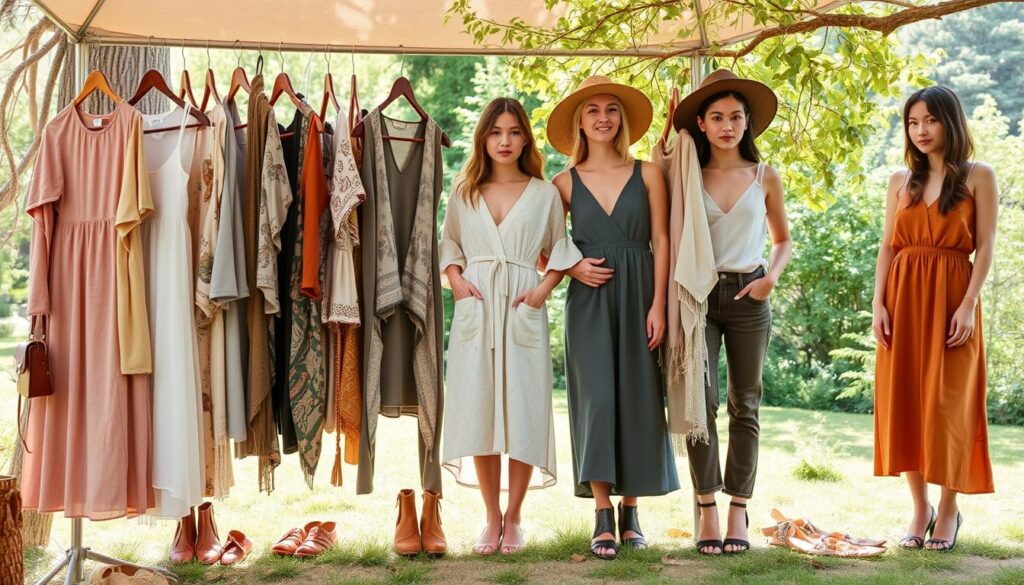
“The true cost of fast fashion is not just what you pay for the item. It’s the environmental and social impact of the whole system.”
By following these tips, you can build a wardrobe that’s good for you and the planet. Every choice you make helps make fashion more sustainable for the future.
Secondhand and Vintage Shopping
The fast fashion industry is harming our planet. But, there’s a way to enjoy stylish clothes while helping the environment. Secondhand and vintage shopping is the answer. It’s good for the planet and offers unique, affordable fashion.
Benefits of Thrift Shopping
Thrift shopping is a green choice that cuts down on waste. It keeps clothes out of landfills and saves resources. Thrift stores have quality, affordable items. You can find unique pieces and make clothes last longer.
Finding Quality Secondhand Items
Looking for secondhand items takes patience and persistence. Search through racks to find designer labels, vintage finds, and gently used clothes. Choose items made well, with classic designs that fit your style.
Popular Online Platforms
Online platforms make secondhand shopping easy. Sites like Vinted and Vestiaire Collective have designer items. Apps like Depop and Poshmark let you buy from individual sellers. The Buy Nothing community is also a great place to find free, quality items.
| Secondhand Shopping Platform | Key Features |
|---|---|
| Vinted | Peer-to-peer resale platform for secondhand clothing, accessories, and more |
| Vestiaire Collective | Online marketplace for pre-owned designer fashion items |
| Depop | Social shopping app for buying and selling unique, vintage, and secondhand items |
| Poshmark | Resale platform for buying and selling new, used, and vintage fashion items |
| Buy Nothing | Community-driven platform for gifting and receiving pre-owned goods for free |
By choosing secondhand shopping and sustainable fashion choices, you help the environment. You also find unique pieces to add to your style.
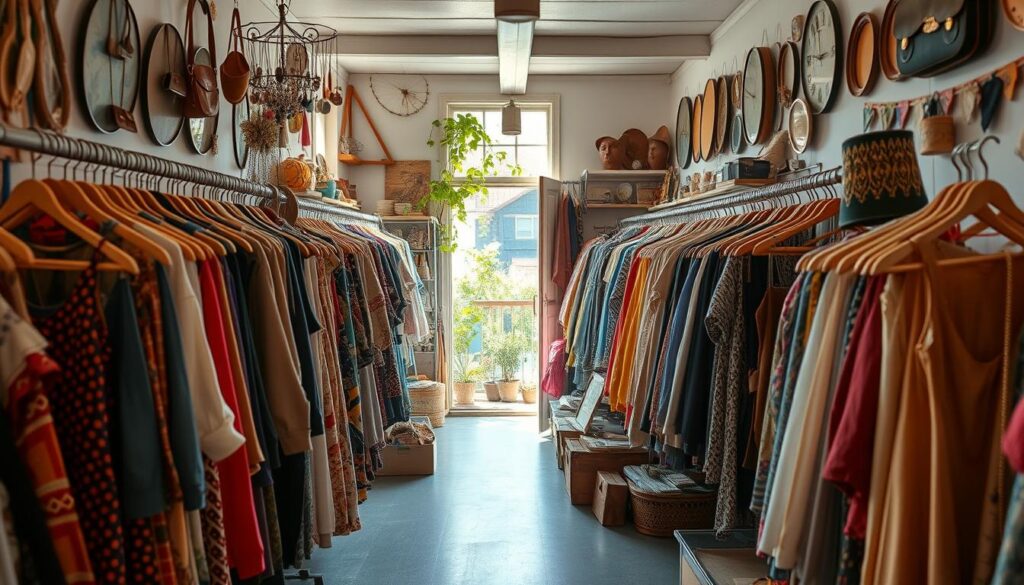
Mindful Shopping Habits
The slow fashion movement is growing fast. It’s key to shop mindfully, choosing sustainability over trends. Researching brands and their sustainable fashion choices helps make values-driven purchases.
Research Before You Buy
Do your homework before buying. Check out Good on You and B Lab to see a brand’s impact. Look for B Corp certifications, showing a brand’s commitment to both profit and purpose.
Collaborating with Clothing Swaps
Clothing swaps are a great way to update your wardrobe without waste. They let you swap gently used clothes, promoting a circular fashion system. Swapping with others also encourages sustainable fashion choices.
Being a Conscious Consumer
Being a conscious consumer means avoiding fast fashion. Focus on quality, timeless pieces. Choose brands that treat workers well and use eco-friendly materials.
| Sustainable Shopping Tip | Impact |
|---|---|
| Unsubscribe from marketing emails | Reduces impulse buys and overconsumption |
| Invest in a capsule wardrobe | Promotes mindfulness and minimizes waste |
| Shop secondhand and vintage | Extends the life of clothing and reduces textile waste |
Alec Leach, author of “The World Is on Fire but We’re Still Buying Shoes,” says something important. Ethical consumption is hard under capitalism. But, mindful shopping can help us move towards a greener fashion future.
Care and Maintenance of Clothing
Proper care and maintenance of your clothing can make it last longer. This reduces the need for frequent replacements. It also supports sustainable fashion choices. Simple practices can help reduce textile waste and support a greener fashion industry.
Washing and Drying Tips
Choose cool or cold water when washing clothes. This saves energy and keeps fabrics in good shape. Don’t wash clothes too much, as it can cause them to wear out faster.
Use eco-friendly laundry products that don’t have harsh chemicals. Air-drying clothes saves energy and prevents damage from machine drying.
Repairing and Upcycling Garments
Don’t throw away clothes that are damaged or worn out. Learn to sew and mend small problems like loose buttons or torn seams. You can also take clothes to a tailor or seamstress for repairs.
Brands like Patagonia, Beyond Retro, and Urban Outfitters show how to upcycle clothes. They turn old garments into unique, special items.
Storing Clothes Sustainably
Proper storage helps keep clothes in good condition. Use garment bags, hangers, and containers to protect them from dust and sunlight. Rotate your clothes with the seasons to avoid overuse.
Store clothes you don’t wear often in a cool, dry place. This prevents mold or mildew. By taking these steps, you help the environment and make your clothes last longer.
Every small action in caring for your clothes helps. It reduces waste and supports a more sustainable fashion industry. Remember, every step counts towards a greener future.
The Role of Technology in Sustainable Fashion
Technology is key in making the fashion world more sustainable. It brings new materials, smart clothes, and virtual fitting rooms. These advancements change how we make sustainable fashion choices and use eco-friendly materials.
Innovations in Sustainable Fabrics
The fashion world is using new tech to make greener fabrics. For example, Colorifix uses bacteria to dye clothes without harmful chemicals. Big names like Adidas and Stella McCartney are using recycled stuff, like plastic bottles, in their designs.
Smart Clothing and Wearable Tech
Now, we have “smart” clothes and gadgets. They can track your body temperature, protect you from the sun, and even make power from your movements. Smart clothes are changing how we see our clothes.
Virtual Fitting Rooms
Virtual fitting rooms and 3D body scans are changing how we shop. They let you find the right fit without trying things on. This cuts down on shipping and returns, making fashion more sustainable.
Technology is helping the fashion world in many ways. It’s making fabrics better, making production easier, and getting people to choose eco-friendly fashion. With these new ideas, the fashion world is becoming greener and more responsible.
Promoting Sustainable Fashion in Your Community
We can all help push the sustainable fashion movement in our local areas. We can do this by hosting fashion events and workshops. We can also work with famous people and use social media to spread the word.
By doing these things, we can make more people aware of the need for eco-friendly clothes. We can help set new standards and encourage others to choose sustainable fashion.
Hosting Fashion Events and Workshops
Hosting events and workshops is a great way to teach about sustainable fashion choices. These can cover how fast fashion hurts the environment and why we should support local artisans. They can also give tips on building a sustainable wardrobe.
By making these events fun and interactive, you can get your community excited about slow fashion. You can help them make better choices when buying clothes.
Collaborating with Local Influencers
Working with local influencers, bloggers, or leaders can really help spread the word about sustainable fashion. These people have a big impact on what others think and do. By teaming up with them, you can reach more people and encourage them to think differently about their clothes.
You can use their influence to talk about sustainable fashion, show off ethical brands, and get people to think about their shopping habits.
Engaging on Social Media Platforms
Social media is a great tool for promoting sustainable fashion. By posting interesting content and joining in on conversations, you can build a community that cares about sustainable fashion. Use pictures and stories to connect with your followers and inspire change.
By sharing your own experiences and talking to your audience, you can create a sense of shared responsibility. This can help motivate people to make positive changes in their fashion choices.

